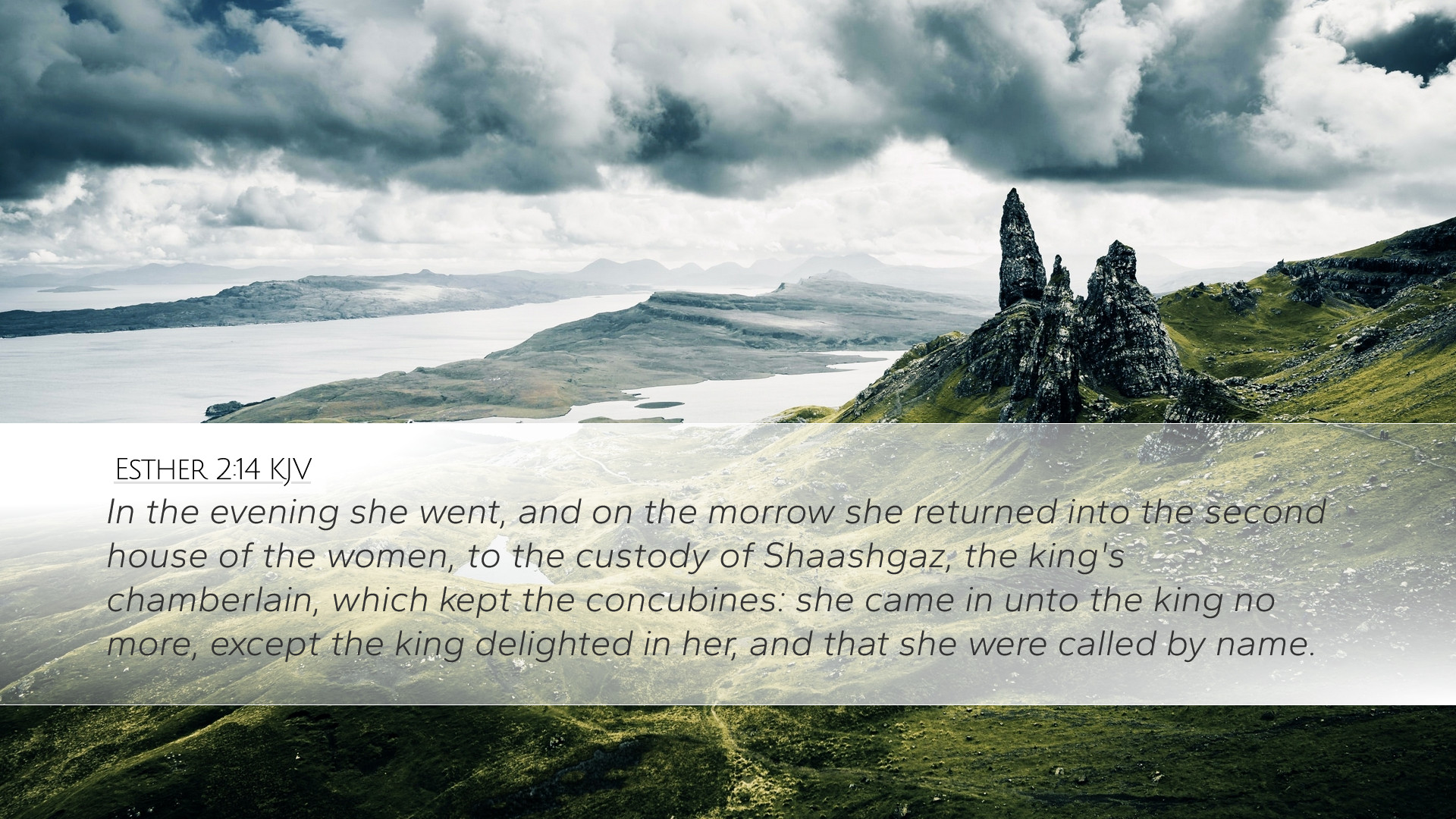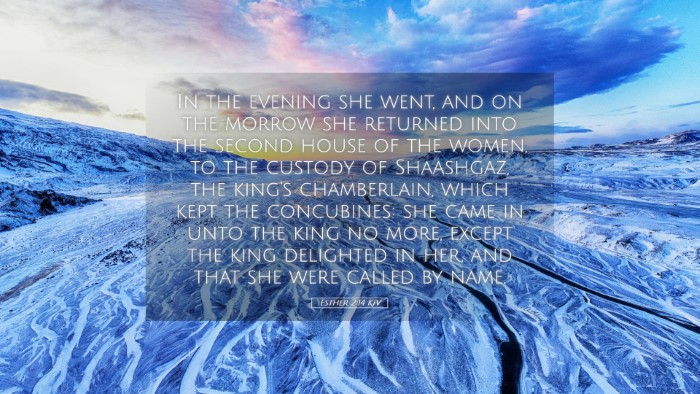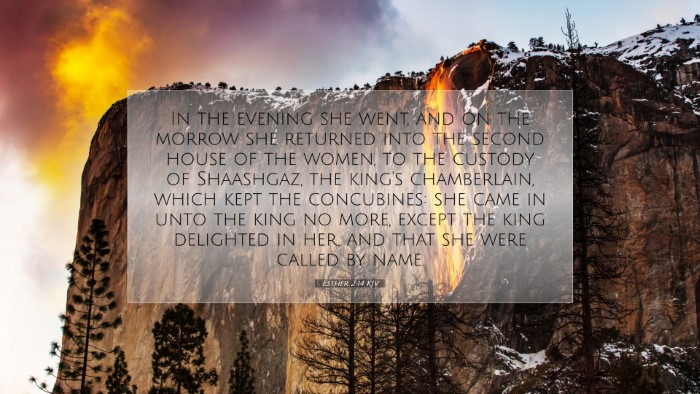Old Testament
Genesis Exodus Leviticus Numbers Deuteronomy Joshua Judges Ruth 1 Samuel 2 Samuel 1 Kings 2 Kings 1 Chronicles 2 Chronicles Ezra Nehemiah Esther Job Psalms Proverbs Ecclesiastes Song of Solomon Isaiah Jeremiah Lamentations Ezekiel Daniel Hosea Joel Amos Obadiah Jonah Micah Nahum Habakkuk Zephaniah Haggai Zechariah MalachiEsther 2:14
Esther 2:14 KJV
In the evening she went, and on the morrow she returned into the second house of the women, to the custody of Shaashgaz, the king's chamberlain, which kept the concubines: she came in unto the king no more, except the king delighted in her, and that she were called by name.
Esther 2:14 Bible Commentary
Commentary on Esther 2:14
Esther 2:14 reads: "In the evening she went; and on the morrow she returned into the second house of the women, to the custody of Shaashgaz, the king's chamberlain, which kept the concubines: she came in unto the king no more, except the king delighted in her, and that she were called by name."
Context and Overview
The Book of Esther provides a remarkable narrative of God’s providence amidst the trials faced by the Jewish people in exile. Esther 2 presents a pivotal moment in which Esther is taken to the king’s palace after the deposing of Queen Vashti, and the commentary on verse 14 offers vital insights into the socio-political climate of Persian rule and the personal trials faced by Esther.
Historical Background
To fully appreciate the significance of Esther’s experience, one must consider the historical context. Following King Xerxes' decision to remove Vashti, he initiates a search for a new queen, leading to the selection of young women from across the empire. Scholars like Matthew Henry emphasize the perilous position of these women, caught between royal expectations and their own fate.
Detailed Commentary
The Fate of the Women
Esther 2:14 highlights a troubling reality: the women, including Esther, were essentially relegated to a life of concubinage if they did not find favor in the king’s eyes. Albert Barnes comments that despite the apparent glamour of royal life, the underlying truths were harsh and dehumanizing. This verse serves as a reminder of the vulnerability of women in ancient cultures.
The Role of Shaashgaz
The mention of Shaashgaz, the chamberlain who kept the concubines, is insightful. Adam Clarke notes that this role underscores the systemic oppression within the persisting patriarchal structures of power. Shaashgaz symbolizes the disconnect between individual aspirations and the dominating power of the ruler, highlighting how Esther and the other women were mere pawns in a political game.
Theological Themes
Divine Providence
One of the central theological themes in the Book of Esther is divine providence. Matthew Henry interprets this passage as indicative of God’s overarching plan—even in seemingly mundane circumstances. Although Esther is placed in a precarious situation, her story reveals how God’s hand guides her through adversity toward a greater purpose. This theme resonates deeply for readers who face trials, reminding them that their paths may also be part of divine orchestration.
The Importance of Identity
Esther’s experience in the king’s palace serves as a reminder of identity’s weight in the face of adversity. As she goes to the king’s house and may return as a mere concubine, maintaining her Jewish identity while navigating royal expectations is crucial. Albert Barnes emphasizes that Esther’s name and Jewish heritage may play a critical role in her eventual actions and decisions throughout the narrative.
Lessons for Pastors and Theologians
Pastoral Care
This verse encourages pastors to consider the plight of those who, like Esther, may feel marginalized or trapped in oppressive circumstances. Adam Clarke suggests that sermons derived from this text could focus on the importance of encouraging individuals facing life’s uncertainties, portraying how God prepares His servants for influence and leadership amid trials.
Encouragement for Students and Scholars
For students and scholars, Esther 2:14 offers rich material for exploring themes of power dynamics, identity formation, and resilience. The narrative juxtaposes the vulnerability of Esther against the might of the Persian Empire, providing a case study on how faith intersects with politics, culture, and personal agency.
Conclusion
Esther 2:14 is a powerful reflection on the complexities of identity, the nature of divine providence, and the realities faced by women in a patriarchal society. Readers are invited to delve deeper, seeking understanding and drawing parallels between Esther's situation and contemporary struggles faced by individuals today. By studying Esther’s journey, one can glean invaluable lessons in faith, resilience, and the hope that God’s purpose prevails even in the direst of circumstances.


